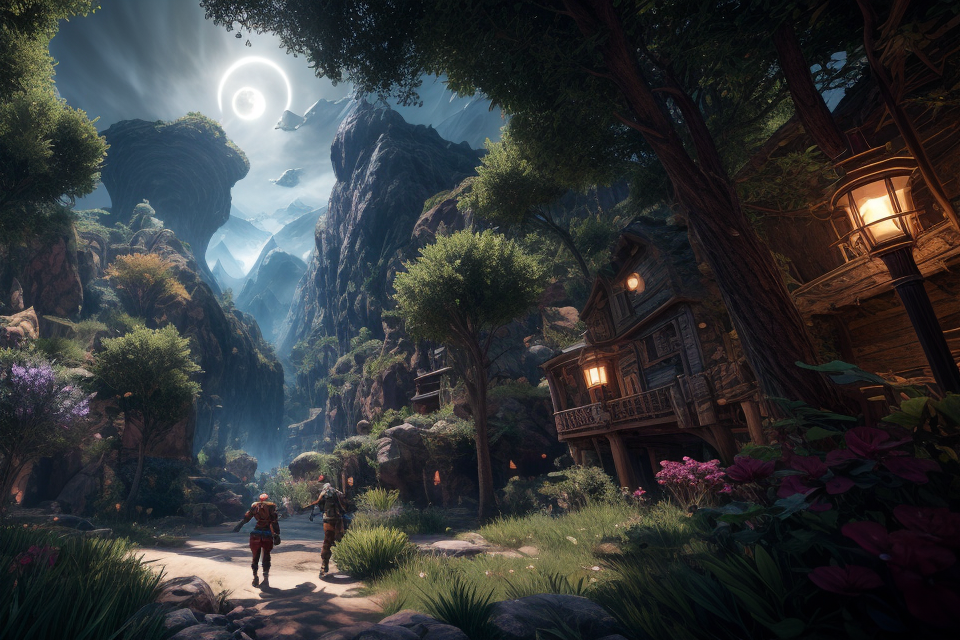The adventure game genre has been a staple of gaming for decades, with players loving the challenge of solving puzzles and uncovering hidden mysteries. But what was the first adventure game? And how has the genre evolved over the years? In this article, we’ll take a look at the evolution of adventure games, from their humble text-based roots to the modern gaming masterpieces we know and love today. Get ready to explore the history of this beloved genre and discover how it has captured the hearts and minds of gamers everywhere.
The Origins of Adventure Games: Text-Based and Graphical
The first text-based adventure games
In the early days of computer gaming, adventure games were primarily text-based. These games, also known as “interactive fiction,” allowed players to navigate a story and make choices that would determine the outcome of the game. The first text-based adventure games were created in the late 1970s and early 1980s, and were inspired by interactive fiction works such as “Colossal Cave Adventure” and “Zork.”
Some of the earliest text-based adventure games included “Mystery House” (1979), “The Adventure of Gnomi” (1981), and “Dungeon” (1982). These games were simple by today’s standards, but they laid the groundwork for the genre and introduced players to the concept of interactive storytelling.
Players would navigate through the game by typing commands into the computer, such as “go north” or “take key.” The game would then respond with a description of the new location or object that the player had encountered. This simple mechanic allowed players to explore and interact with the game world in a way that had never been possible before.
Text-based adventure games were also often accompanied by a “hint book” or “walkthrough” that would provide players with clues and guidance on how to progress through the game. This was especially helpful for players who were stuck or had difficulty understanding the game’s mechanics.
Overall, the first text-based adventure games were simple but innovative, and laid the groundwork for the genre that would become a staple of computer gaming for decades to come.
The emergence of graphical adventure games
In the late 1970s and early 1980s, the first graphical adventure games were developed, marking a significant turning point in the evolution of the genre. These games combined the text-based interface of early adventure games with simple graphics, allowing players to explore virtual worlds in a more immersive way. Some of the pioneering titles in this genre include:
- Mystery House (1979): Developed by the game’s designer, Roberta Williams, for the Apple II computer, Mystery House was one of the first graphical adventure games. The game featured simple graphics and text-based input, allowing players to explore a haunted house and solve puzzles.
- Zork (1979): Originally created as a text-based adventure game, Zork was later adapted into a graphical adventure game for the Apple II computer. The game featured a vast, fantasy world to explore, complete with puzzles, treasures, and dangerous creatures.
- King’s Quest (1980): Developed by Sierra On-Line, King’s Quest was another early graphical adventure game. The game followed the adventures of King Graham and his family as they explored a fantasy world filled with magic, monsters, and puzzles.
These early graphical adventure games laid the groundwork for the more complex and sophisticated games that would follow in the 1980s and beyond. They demonstrated the potential of combining text-based gameplay with graphics, and inspired a generation of developers to push the boundaries of what was possible in the adventure game genre.
The Golden Age of Adventure Games: The 1980s and 1990s
The rise of popular franchises
During the 1980s and 1990s, adventure games experienced a surge in popularity, with several franchises emerging as fan favorites. Some of the most notable franchises that rose to prominence during this period include:
- King’s Quest: Developed by Sierra On-Line, King’s Quest was one of the earliest and most successful adventure game series. The game follows the adventures of King Graham and his family as they explore a fantastical world filled with magic, puzzles, and danger. The series was known for its challenging puzzles, engaging storylines, and colorful characters.
- Mystery House: Developed by Roberta Williams, Mystery House was another popular adventure game series that debuted in the 1980s. The game follows the adventures of a young detective as they explore a haunted mansion filled with hidden passages, secret rooms, and dangerous traps. The series was known for its atmospheric graphics, challenging puzzles, and intricate storylines.
- Monkey Island: Developed by LucasArts, Monkey Island was a beloved adventure game series that debuted in the late 1980s. The game follows the adventures of a young pirate named Guybrush Threepwood as he explores a Caribbean-inspired world filled with zany characters, wacky puzzles, and dangerous obstacles. The series was known for its humorous writing, memorable characters, and engaging storylines.
- The Secret of Monkey Island: Released in 1990, The Secret of Monkey Island was the first game in the Monkey Island series. The game follows Guybrush Threepwood as he sets out to become a pirate and encounters a host of eccentric characters, including the evil Governor LeChuck and the enigmatic Elaine Marley. The game was praised for its engaging storyline, colorful graphics, and challenging puzzles.
- The Curse of Monkey Island: Released in 1991, The Curse of Monkey Island was the second game in the Monkey Island series. The game follows Guybrush Threepwood as he tries to lift the curse that has turned him into a frog and embarks on a quest to defeat Governor LeChuck once and for all. The game was known for its humorous writing, memorable characters, and engaging storyline.
- Grim Fandango: Released in 1998, Grim Fandango was a critically acclaimed adventure game developed by LucasArts. The game follows the adventures of Manny Calavera, a travel agent in the afterlife, as he investigates the mysterious disappearance of his client and uncovers a dark conspiracy in the process. The game was praised for its engaging storyline, memorable characters, and innovative gameplay mechanics.
These franchises, among others, helped to establish adventure games as a beloved genre in the gaming world and paved the way for future innovations in the field.
The impact of new technologies
During the 1980s and 1990s, adventure games experienced a golden age with the emergence of new technologies that significantly impacted their development. The introduction of graphics and sound cards, higher storage capacities, and improved processing power allowed for more immersive and visually appealing experiences. Here are some key developments that transformed the genre:
- Graphical Adventures: The early 1980s saw the transition from text-based adventures to graphical adventures, with games like King’s Quest (1984) and Mystery House (1980) paving the way. These games used simple 2D graphics and animations to create a visual representation of the environment and characters, enhancing the overall gaming experience.
- Point-and-Click Interface: With the introduction of the mouse in the late 1980s, adventure games began incorporating point-and-click interfaces. This innovation simplified gameplay mechanics, making it easier for players to interact with the game world and objects. Examples of games that adopted this interface include Maniac Mansion (1987) and The Secret of Monkey Island (1990).
- CD-ROM Technology: The early 1990s saw the introduction of CD-ROM technology, which allowed for larger storage capacity and higher-quality audio and video content. This advancement enabled the development of more complex and detailed game worlds, as well as the inclusion of voice acting and full motion video sequences in games like The 7th Guest (1993) and Myst (1993).
- 3D Graphics: As computer processing power continued to improve, the 1990s saw the emergence of 3D graphics in adventure games. This allowed for more realistic environments and character models, enhancing the sense of immersion. Games like Myst III: Exile (1999) and Grim Fandango (1998) showcased the potential of 3D graphics in adventure game design.
- Multimedia Integration: In the late 1990s, adventure games began integrating multimedia elements, such as video clips, music, and live-action cutscenes. This allowed for more engaging storytelling and character development. Examples of games that employed multimedia features include Sam & Max: Hit the Road (1993) and The Longest Journey (1999).
These technological advancements in the 1980s and 1990s transformed adventure games from simple text-based experiences to visually stunning and immersive interactive stories, laying the foundation for the modern adventure game genre.
The Modern Era of Adventure Games: The 2000s and Beyond
The shift towards more realistic graphics
In the 2000s, adventure games underwent a significant transformation in terms of visuals. With the advancements in technology, developers started focusing on creating more realistic graphics that would immerse players in the game world. This shift was largely driven by the growing popularity of 3D gaming and the increasing power of gaming hardware.
One of the most notable examples of this shift is the 2004 game, “God of War”. This game utilized advanced graphics technology to create a breathtakingly realistic world, complete with detailed character models and stunning environments. This set a new standard for adventure games and inspired many developers to follow suit.
Another key factor in the shift towards more realistic graphics was the rise of motion capture technology. This allowed developers to create more lifelike animations for their characters, which added an extra layer of immersion for players. Games like “Uncharted” and “The Last of Us” have become renowned for their use of motion capture, which has helped to make their characters feel more real and relatable.
The trend towards more realistic graphics has also been driven by the increasing demand for high-quality visuals in the gaming industry. As gamers have come to expect stunning visuals from their games, developers have had to respond by creating ever more impressive graphics. This has led to a boom in the use of advanced graphics engines and cutting-edge technology, such as ray tracing and ultra-high-definition textures.
Overall, the shift towards more realistic graphics has been a defining feature of the modern era of adventure games. By creating more immersive worlds and lifelike characters, developers have been able to draw players into their games like never before.
The rise of interactive storytelling
In the 2000s, adventure games underwent a significant transformation as developers sought to create more immersive and engaging experiences for players. One of the key developments during this time was the rise of interactive storytelling, which allowed players to actively participate in the narrative and shape the course of the game.
This approach was exemplified by games such as BioShock (2007), which featured a complex and morally ambiguous story that reacted to the player’s choices, and Heavy Rain (2010), which utilized a unique control system that allowed players to directly influence the story’s outcome.
These games represented a departure from the traditional linear narratives of earlier adventure games, and marked a significant step towards a more dynamic and personalized gaming experience.
Another notable development during this period was the increased use of branching narratives, which allowed players to make meaningful choices that would impact the game’s story and conclusion. This approach was employed in games such as The Walking Dead (2012), which featured a narrative that branched based on the player’s decisions, creating a sense of agency and investment in the story.
In addition to these innovations, the 2000s also saw the rise of social adventure games, which incorporated elements of social media and online multiplayer to create a more collaborative and community-driven experience. Games such as Mystery of the Ancient Temple (2014) and Criminal Case (2012) utilized this approach, allowing players to work together to solve puzzles and uncover clues.
Overall, the rise of interactive storytelling in the 2000s represented a significant milestone in the evolution of adventure games, as developers sought to create more engaging and personalized experiences for players. By incorporating branching narratives, social elements, and other innovations, these games helped to redefine the genre and pave the way for future developments.
The Influence of Adventure Games on Modern Gaming
The impact on game design and mechanics
Adventure games have had a profound impact on the gaming industry, particularly in terms of game design and mechanics. Many of the conventions and principles that are now standard in modern gaming can be traced back to the early days of adventure games. Here are some of the ways in which adventure games have influenced game design and mechanics:
- Interactive storytelling: Adventure games were among the first to incorporate narrative elements into gaming, allowing players to make choices that affected the story’s outcome. This approach to interactive storytelling has since become a staple of many popular games, including the “walking simulator” genre and choice-based games.
- Puzzle-solving: Adventure games often required players to solve puzzles in order to progress through the game. This mechanic has since been adapted and refined in many different genres, from platformers to point-and-click games.
- Character development: Many adventure games featured complex characters with their own motivations and backstories. This focus on character development has since become a hallmark of modern gaming, with many games featuring deep, nuanced characters and branching storylines.
- Environmental storytelling: Adventure games often used their environments to tell a story or provide clues to puzzles. This approach to environmental storytelling has since become a standard technique in many genres, from open-world games to first-person shooters.
- Non-linear gameplay: Adventure games often allowed players to explore different areas in any order they desired, providing a sense of freedom and exploration. This non-linear approach to gameplay has since become a standard feature in many modern games, particularly open-world and sandbox games.
Overall, the impact of adventure games on modern gaming can be seen in the many conventions and principles that have become standard in the industry. From interactive storytelling to character development, puzzle-solving to environmental storytelling, adventure games have left a lasting legacy on the world of gaming.
The enduring appeal of the genre
- Emotional Engagement: Adventure games have a unique ability to create an emotional connection with players through their immersive storytelling and character development. This emotional engagement is a significant factor in the enduring appeal of the genre.
- Puzzle Solving: The challenge of solving puzzles is a key aspect of adventure games, which contributes to their lasting popularity. Players enjoy the sense of accomplishment that comes from unraveling the mystery and progressing through the game.
- Exploration and Discovery: Adventure games often allow players to explore virtual worlds, which fuels the curiosity and desire for discovery in gamers. This aspect of the genre appeals to those who enjoy the thrill of uncovering hidden secrets and uncharted territories.
- Replay Value: Many adventure games have branching storylines and multiple endings, which encourages players to replay the game to experience different outcomes. This adds to the replay value of the game and keeps players engaged even after they have completed it once.
- Accessibility: In recent years, adventure games have become more accessible to a wider audience, with more varied genres and platforms available. This accessibility has contributed to the enduring appeal of the genre, as it allows a broader range of players to enjoy the unique experiences that adventure games offer.
The Future of Adventure Games: Trends and Predictions
The rise of virtual reality and augmented reality
As technology continues to advance, virtual reality (VR) and augmented reality (AR) are poised to play a significant role in the future of adventure games. These immersive technologies offer the potential to transport players to fully realized digital worlds, providing a level of immersion and interactivity that has never been possible before.
VR and AR: A New Frontier for Adventure Games
The integration of VR and AR technologies into adventure games promises to revolutionize the way players experience these titles. By providing players with a fully immersive digital environment, VR and AR can create a more engaging and realistic gaming experience. This is particularly true for adventure games, which often rely on storytelling and exploration to drive gameplay.
The Potential of VR and AR in Adventure Games
VR and AR technologies offer a number of potential benefits for adventure games. For example, VR headsets can provide players with a fully immersive 3D environment, allowing them to explore digital worlds in a way that feels more like reality. AR, on the other hand, can overlay digital elements onto the real world, creating a more seamless integration of the digital and physical worlds.
Challenges and Opportunities
While the integration of VR and AR technologies into adventure games presents many opportunities, it also poses a number of challenges. For example, VR and AR devices can be expensive and may require significant hardware upgrades to run the most demanding games. Additionally, the technology is still relatively new, and developers may face technical difficulties in creating games that take full advantage of these technologies.
Despite these challenges, the potential for VR and AR in adventure games is undeniable. As the technology continues to evolve and become more accessible, it is likely that we will see more and more adventure games incorporating these technologies to create truly immersive gaming experiences.
The increasing importance of player choice and agency
Adventure games have come a long way since their text-based roots, and one of the most exciting trends in the genre’s evolution is the increasing importance of player choice and agency. Gone are the days of simple linear storylines and predetermined player paths; today’s adventure games are all about giving players the freedom to explore, interact, and make decisions that shape the course of the game.
Here are some of the ways in which player choice and agency are becoming more important in adventure games:
- Non-linear storytelling: Modern adventure games are often designed with multiple paths and branching storylines, allowing players to make choices that significantly impact the outcome of the game. This gives players a sense of agency and control over their experience, allowing them to shape the story in a way that feels uniquely their own.
- Complex characters: As adventure games have evolved, so too have the characters that inhabit them. Today’s games often feature well-developed, morally ambiguous characters with complex motivations and backstories. This allows players to make choices that reflect their own values and beliefs, leading to a more immersive and personalized experience.
- Interactive environments: Many modern adventure games feature highly detailed and interactive environments, allowing players to explore and interact with their surroundings in a more realistic and intuitive way. This creates a sense of agency and empowerment, as players are able to explore the game world in a way that feels more like real life.
- Choice-driven gameplay: Some adventure games are designed with choice-driven gameplay in mind, allowing players to make meaningful choices that affect the outcome of the game. This can include everything from dialogue options to branching paths and multiple endings, giving players a sense of agency and control over their experience.
Overall, the increasing importance of player choice and agency in adventure games is a trend that is likely to continue as the genre evolves. By giving players more control over their experience, adventure games can become more immersive, personalized, and engaging, leading to a more satisfying and rewarding gaming experience overall.
The Legacy of Adventure Games: The Impact on Popular Culture
The influence on other genres
Adventure games have had a profound impact on popular culture, transcending their own genre and influencing the development of other game types. The innovative storytelling, puzzle-solving, and character development found in adventure games have inspired and informed the creation of numerous other genres. Some of the most significant influences can be seen in the following areas:
- Interactive Storytelling: Adventure games were pioneers in incorporating rich narratives and character development, paving the way for other genres to focus on storytelling. Games like “The Walking Dead” and “Life is Strange” owe a significant debt to the storytelling innovations introduced by adventure games.
- Casual Gaming: The accessibility and user-friendly nature of many modern adventure games have contributed to the rise of casual gaming. Games like “The Room” series and “Firewatch” offer accessible, narrative-driven experiences that appeal to a wide audience, a trend that can be traced back to the early days of adventure games.
- Visual Novels: The adventure game’s combination of narrative and puzzle-solving elements has also influenced the development of visual novels, such as “Never Have I Ever” and “A Hat in Time”. These games focus on storytelling and character development, often featuring branching narratives and player choice, similar to the choices made by players in classic adventure games.
- Open-World Games: The desire to explore and interact with game worlds was first popularized in adventure games like “Zelda” and “King’s Quest”. These games allowed players to explore vast, interconnected environments, a concept that has since been expanded upon in open-world games like “The Legend of Zelda: Breath of the Wild” and “Red Dead Redemption 2”.
- Indie Games: The indie game scene has seen a surge of titles inspired by adventure game mechanics and narratives. Developers like Team Cherry (“Hollow Knight”) and Supergiant Games (“Hades”) have created critically acclaimed games that draw on the best elements of classic adventure games while pushing the boundaries of the genre.
These examples demonstrate the lasting influence of adventure games on popular culture and the gaming industry as a whole. The innovations and ideas introduced by these games continue to shape the development of new titles across various genres, making the legacy of adventure games an enduring one.
The enduring popularity of classic adventure games
Despite the passage of time and the emergence of newer genres, classic adventure games continue to captivate players worldwide. This enduring popularity can be attributed to several factors, including:
- Emotional Connection: Classic adventure games often feature rich narratives and well-developed characters, allowing players to form emotional connections with the game world and its inhabitants. This emotional investment creates a lasting impression and contributes to the game’s staying power.
- Pioneering Spirit: As some of the earliest examples of interactive storytelling, classic adventure games serve as pioneers in the gaming industry. Their innovative approaches to game design and narrative have paved the way for future titles, making them a cornerstone of gaming history.
- Cultural Significance: Classic adventure games have transcended their original purpose as entertainment, becoming cultural touchstones that reflect the societal and technological advancements of their respective eras. They represent a unique blend of art, storytelling, and technology that continues to resonate with players today.
- Timeless Themes: The themes explored in classic adventure games often touch on universal human experiences, such as self-discovery, friendship, and loss. These timeless themes make the games accessible and relatable to players of all ages, contributing to their enduring appeal.
- Community and Fandom: A strong community of players and fans has developed around classic adventure games, fostering a sense of shared experience and nostalgia. This collective appreciation for the games has helped to sustain their popularity and has given rise to dedicated fan sites, forums, and events.
- Re-Releases and Remasters: The resurgence of interest in classic adventure games has led to the re-release and remastering of many iconic titles. This renewed availability has allowed new generations of players to experience these games and has contributed to their continued popularity.
The enduring popularity of classic adventure games is a testament to their lasting impact on the gaming industry and popular culture at large. As technology continues to advance and new genres emerge, these pioneering titles remain relevant and beloved by players worldwide.
FAQs
1. What was the first adventure game?
The first adventure game is considered to be “Colossal Cave Adventure,” which was created in 1976 by Will Crowther. It was originally designed as a text-based game for the PDP-10 mainframe computer and was later ported to other platforms. The game was inspired by the Mammoth Cave in Kentucky and featured a player character who had to navigate through the cave by solving puzzles and gathering treasures. The game was revolutionary for its time and laid the foundation for the entire adventure game genre.
2. How has the adventure game genre evolved over time?
The adventure game genre has evolved significantly since its inception in the 1970s. Early adventure games were primarily text-based and focused on simple puzzles and exploration. As technology advanced, adventure games began to incorporate graphics, animation, and more complex puzzles. In the 1990s, the adventure game genre experienced a surge in popularity with the release of games like “The Secret of Monkey Island” and “Myst.” Today, adventure games come in a variety of forms, from point-and-click games to action-adventure games, and continue to push the boundaries of what is possible in gaming.
3. Who are some notable adventure game developers?
There have been many notable adventure game developers over the years, including LucasArts, Sierra On-Line, and Telltale Games. LucasArts was responsible for popular games like “Monkey Island” and “Grim Fandango,” while Sierra On-Line created the “King’s Quest” series. Telltale Games is known for its modern take on adventure games, with titles like “The Walking Dead” and “Batman: The Telltale Series.” Other notable adventure game developers include Infocom, Legend Entertainment, and Double Fine Productions.
4. What are some of the most influential adventure games?
There have been many influential adventure games throughout the genre’s history. “Colossal Cave Adventure” is considered to be the first adventure game and laid the foundation for the genre. “Zork” was another influential game that was released in the late 1970s and early 1980s and helped to popularize the text-based adventure game format. “Myst” was a landmark game in the 1990s that used a combination of puzzles and exploration to create an immersive gaming experience. More recently, “The Walking Dead” has been influential in bringing adventure games to a wider audience through its use of storytelling and choice-based gameplay.
5. What are some modern adventure games that I should check out?
There are many great modern adventure games that you should check out. Some popular titles include “Life is Strange,” “Firewatch,” “What Remains of Edith Finch,” and “Bastion.” These games offer a variety of experiences, from choice-based storytelling to exploration and puzzle-solving. Additionally, there are many indie adventure games that are worth checking out, such as “Gone Home,” “Everybody’s Gone to the Rapture,” and “Abzû.” These games often offer unique and thought-provoking experiences that are worth exploring.









